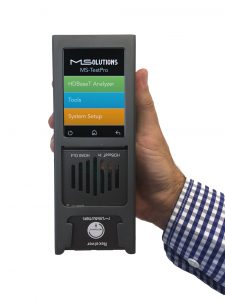As we enter the Internet Age of Things (IoT), HDBaseT technology is a vital communication channel for home, office or smart enterprises. Since its invention first introduced in 2010, HDBaseT has become the world standard for ultra-high definition (UHD) video and audio transmission using standard network cable,. Using HDBaseT protocol, five different media parameters are simultaneously transmitted (a function known as 5Play): uncompressed video signals, Ethernet, USB, control such as RS232 serial communication and IR, and power of up to 100 watts.


image: MS-TestPro – the only hand
held HDBaseT tester
Unlike common RF or Wifi-based IoT technologies, HDBaseT is a high quality, cost effective broadband channel that prevents system failures and data loss. While the current bandwidth for Wifi is not sufficient for quality video transmission, increasing bandwidth is expensive and using the current bandwidth requires compression of the transmitted video causing delay quality degradation and stability issues. In addition, the use of Ethernet networks requires broad and extensive knowledge of network settings to enable high quality transmissions. As a result, in order to achieve and maintain high quality, it is usually necessary to use a designated video channel from the broadcast source to the destination. HDBaseT does not require any settings at all.
As such, the unique capabilities of HDBaseT, especially as compared to competing technologies on the market, have made it the platform of choice for a wide range of media-intensive industries – projectors, vehicles, industrial computers, smart homes and more.
HDBaseT – The Untold Story
Many installers who work with HDBaseT relate to it as Plug & Play technology. This way of relating to HDBaseT does not reflect the whole story. The technology does not require configuration during the installation or in-depth knowledge of networks and is therefore simple to connect and greatly facilitates setting up the network (although it requires knowledge and experience in infrastructure). Sometimes, even the most professional and thorough installer will receive a call back to the client site due to broadcasting channel failure and the need to make corrections. Today, the standard way to test the quality of the line is only by visual inspection of the image on the display or the projector, without any means of testing broadcast parameters. In fact, up to now, it has not been possible to obtain parameters on the quality of the installation, leaving installers with no real way to check the cable quality or infrastructure quality in general while installing.
HDBaseT failures can occur for many reasons, such as adding noise sources near existing networks that can cause electrostatic noise and random transmission disruptions. In most cases, failures of this type simply cannot be seen and / or detected by visual inspection. That being said, this is a situation that is unacceptable to the end user, for whom each and every one in the installation chain is at fault – from the installer to the equipment supplier.
In addition, high resolution transmissions, which the system probably was not tested for during installation, will expose the network to greater sensitivity to environmental interference. In other words, when relying solely on visual inspection, HDBaseT systems tested at 1080P transmission resolution will be more resilient to failures than 4K transmission systems that appear to be sound at the time of installation. Problems such as these are likely to grow and multiply in the “smart” world, where many devices around us will rely on an extensive communications network in order to work. This is exactly why many systems and devices that worked perfectly when first installed mysteriously fail the next day.
For these and other reasons, it is imperative today that IoT installers have a comprehensive understanding of HDBaseT technology and understand the way in which problems can be diagnosed, and even prevented in advance, when laying the network infrastructure. The market today offers a wide range of systems using HDBaseT technology, each with unique needs and capabilities. As a result, any attempt to try deal with HDBaseT as a “black box”, without really understanding it, will be frustrating, inefficient, will take longer than planned, and may prove to be unprofitable. Let’s see how all of that can be avoided and how to easily adopt advanced IOT technologies.
Interoperability is the name of the game
A well-known rule in the HDBaseT world is that not all systems are capable of supporting all the elements transmitted in HDBaseT using 5Play technology. As a result, the ability of two devices with HDBaseT channels to work in concert is not obvious. Coordinated operation is known as the interoperability or compatibility of the HDBaseT device.
Testing the HDBaseT interoperability of devices saves time and money both for the installer and for the end user. It enables freedom of choice between different brands and products, and greatly improves the ability of home systems and smart factory designers to meet the exact needs of each customer and adapt themselves to the system’s topology. Ignoring the issue of reciprocity and/or compatibility may cause problems that affect the overall functionality and quality of the system and cause technical problems, such as lack of control or inability to support high transmission quality (when 4K content is transmitted, for example).
Many AV and IT installers and integrators are not aware of the features of 5Play HDBaseT, and, as such, are unaware of their responsibility to look closely at the compatibility of HDBaseT channels (device technical specifications must be checked to determine whether the specifications are supported or not supported by the remote side). For example, it is not possible to control an HDBaseT video projector using RS232 serial communication if the projector does not support serial transmission.
In other words, even when connecting two devices with an HDBaseT channel, it is imperative to ascertain the channel attributes supported by the manufacturer, including support for 5Play. This data is not always easily or fully detectable, especially when a significant period of time has elapsed since the installation date. To overcome this problem, we created the MS-TestPro, the only testing device in the world capable of testing in seconds all the various types of HDBaseT channels available on the market and providing information on 5Play elements from all the manufacturers in the world. The MS-TestPro is the only test device in the world today that can test and validate HDBaseT Spec. 2.0 systems, the most advanced systems on the market.
The MS-TestPro is used in the US, Canada and Europe. The largest integration companies in the US, which have already adopted it as an integral part of their test equipment, report savings of up to 30% in time and money, while significantly improving customer satisfaction with the quality of the installation service.
In the age of IOT quality is not a dirty word
The truth of the famous proverb that the strength of each chain is measured by its weakest link is even more valid when it comes to complex IOT infrastructures required to deliver quality content at UHD level of 4K or higher. If the transmission quality of the system is poor, then any component, smart and advanced as it may be, will simply not work. While HDBaseT provides an excellent platform for 4K UHD broadcasts, inappropriate connections and external interference can have a negative impact on system performance.
It is therefore important to check the quality of the HDBaseT link broadcast for both sides, uplink and AUX channels. The reason that it is so important is that HDBaseT is an asymmetric channel and the SNR ratio is different for each transmission direction. It is much more sensitive at uplink so the installer must be aware of the MSE parameters values that reflect the signal-to-noise ratio (SNR) in the HDBaseT channel. The higher the absolute value of the MSE, the higher the HDBaseT quality will be (i.e., -19 dB better than -18db). The installer should ensure that SNR is high and immuned to external interference. So as to avoid line failures, it is necessary to determine the correct domain for each specific HDBaseT device.
Another point is the need to protect the HDBaseT components and their performance levels by installing and updating software. Using the latest and most up-to-date version of HDBaseT (we know that a version update usually fixes bugs and improves performance) can be a significant factor in improving transmission quality, for example. In regards to software updates, every port and connection is suspect until proven otherwise. Using the MS-TestPro, HDBaseT firmware and port upgrades can be performed quickly and easily via link, eliminating the need for physical access to each unit.
It is possible to make all of the aforementioned processes much simpler and more efficient by using the MS-TestPro to check the entire system in one simple operation. The MS-TestPro can analyze any and all types of HDBaseT Tx, Rx and PoH (Power over HDBaseT), and provides a highly efficient testing platform for HDBaseT devices including sink & source units, and up to 100 meters of CAT5e or higher quality cables. Moreover, the MS-TestPro is capable of confirming the compatibility of the HDBaseT infrastructure to deliver 4K quality content, which is particularly sensitive to errors since requires data transmission that is four times faster on a limited PAM8 to PAM16 channel.


Ariel Marcus


Eliran Toren
The need for increased reliability and accountability when installing IOT systems
HDBaseT technology provides a platform with excellent noise immunity, but it also has a breaking point, where frequency and error level overwhelm the system. When that happens, it is apparent to everyone as audio, video and data transmissions begin to “stutter” or fail completely. In simple social or commercial environments, communication failures can be annoying, but they are not life threatening. In medical, safety, or military environments, these same malfunctions can be of great consequence. Given the limitations of each given system, the desired solution is to obtain the fastest communication possible given the system data while maintaining a constant and accurate flow of data. Exactly for this reason, we have developed the MS-TestPro’s unique ability to produce a Cable Certification Report, which can be transferred to both computers and smartphones, specifying the quality and performance of the HDBaseT system while transmitting high quality 4K UHD data.
Belden Inc., the world’s largest cable maker and a world leader in signal transmission solutions for mission-critical applications, recently announced the introduction of a new HDBaseT media cable to the 4K Ultra-High Definition (UHD) Media Cables market. Integrators certified by the AV Partnership Alliance who install Belden’s HDBaseT cables are eligible to receive a 25-year extended warranty and Lifetime Application Assurance Program. Belden will approve the warranty only after receiving a cable integrity report that records the results of the installation diagnostics done using the MS-TestPro of MSolutions, as a guarantee of the integrity of the cabling system.
So, while there is no limit to how much you can invest in any infrastructure, when dealing with advanced media and data transfer in IOT environments, the quality and reliability of the cable infrastructure is critical. Large manufacturers understand this and in the near future we expect to see many solutions in the industry that are directed not only towards technological progress and applications, but also, and more importantly, towards infrastructure and network solutions that will support the growing demands of the market.







